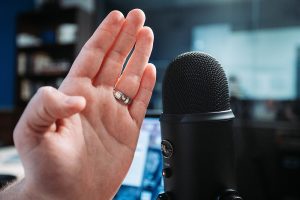Introduction to creating great audio
Creating great audio
When developing content for learning online one of the crucial elements is having great audio. You can make a great video but if the audio is poor it can greatly detract from the learning experience. This section provides the information you need to create great audio to capture your learners attention.
What is great audio?
Here are the key components that determine great audio.
- Audio free from background noise. Audio that contains a lot of background noice makes it harder for students to concentrate on you and what you are saying. Subconsciously the brain is trying to decipher all of the sounds and put them into context. This can quickly create fatigue and students will find it difficult to learn. Background noises include loud fans, A/C units, wind, other voices, environmental noise.
- Audio free from distractions. If there is are distracting noises in your audio it can immediately disrupt the learning experience. These include things like dogs barking, keyboard and mouse clicking, people talking, banging, ringing, etc.
- Audio that is loud, but not too loud. When recording audio it is important to record at the proper volume to ensure the student can hear you. It is also important the audio is not too loud. When using the recording software check that the recording volume is between -6dB to -3dB.
Pro Tip: Camtasia is a supported tool you can use to create great audio and video. Here are a number of tutorials for creating and editing audio.
- Audio that captures the students attention. Once you have mastered some technical aspects of recording great audio, it is is equally important that you speak in an engaging way. Use inflection in your voice, speak naturally with a quick, conversational pace (about 120-150 words per minute). Communicate your passion for your subject through your voice and you will keep learners engaged.
- Audio that avoids errors. When you are recording your audio it is important that you speak clearly and deliberately. This effects learning and enables automatic captioning services to better distinguish what is being said. If you make a mistake, pause, and start again. You can easily edit mistakes using software to make it appear seamless.
How to record great audio
Now that we understand what makes great audio we can begin to learn how to avoid those issues and record great audio. Here are some tips to get you started. We can create great audio using four simple principles: 1. Listen carefully, 2. Get close, 3. Get cozy, 4. Use voice-over.
- Listen carefully. As we mentioned above, distracting and noisy backgrounds can ruin a great audio recording. Before recording, listen carefully to the noise in the room and do whatever you can to eliminate those sounds while recording. If there is a constant noise in the background – like a fan – record for 30 seconds before speaking. This will capture just the noise in the background. Some software will enable you to remove this noise.
Pro Tip: Record a few seconds of audio then stop and listen to it. Do you like how it sounds? Is it loud enough? Are there any distracting noises? Make necessary adjustments before recording your full session.
- Get Close. The closer you are to the mic the more it will capture your voice and the better you will sound. The rule of thumb is 4 fingers away from the mic.

Image source: https://www.nccaudio.com/post/how-to-use-a-yeti-usb-microphone
- Get Cozy. It sounds silly, but one of the best places to record great audio is in a closet. Or any room that will absorb noise with soft wall coverings. Rooms with hard walls, concrete, or empty space will cause sound to bounce around and sound thin, making it hard to hear your voice clearly.
- Use voice-over. Sometimes you have to do a recording and the room is noisy or your voice just isn’t working. No problem. Use that time to create your content and then record just your voice later when you can control the environment to get great audio.
Next Steps
Now that you have a fundamental understanding of what it takes to create great audio, let’s look at how to create audio with PowerPoint.

